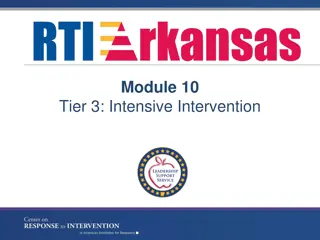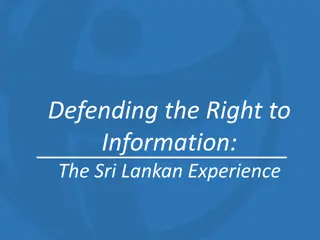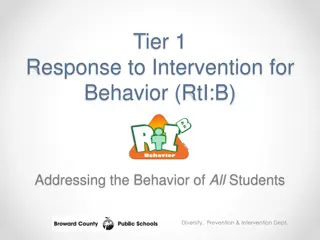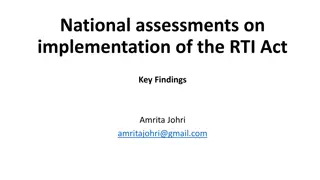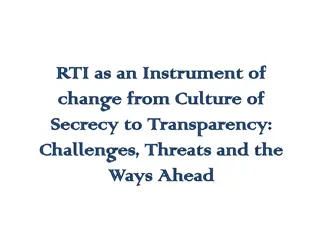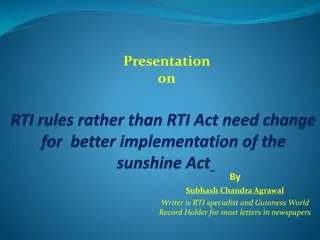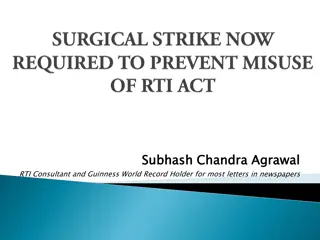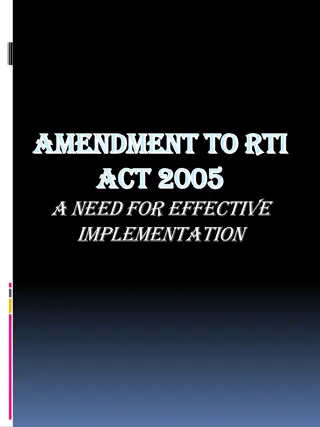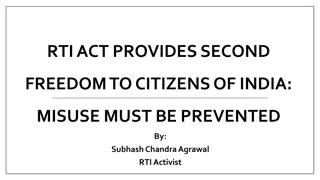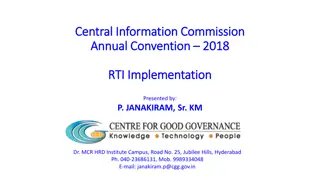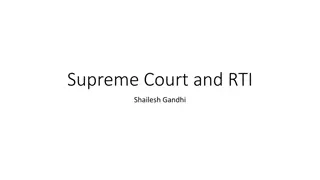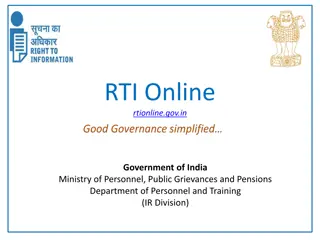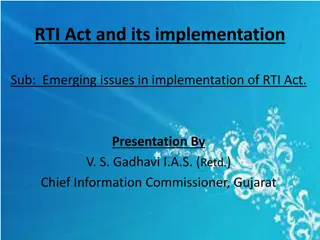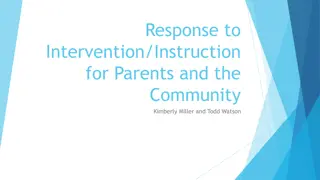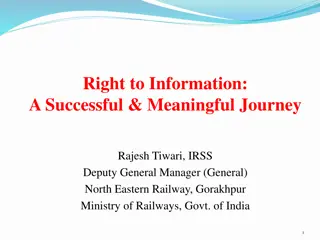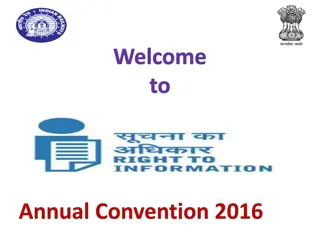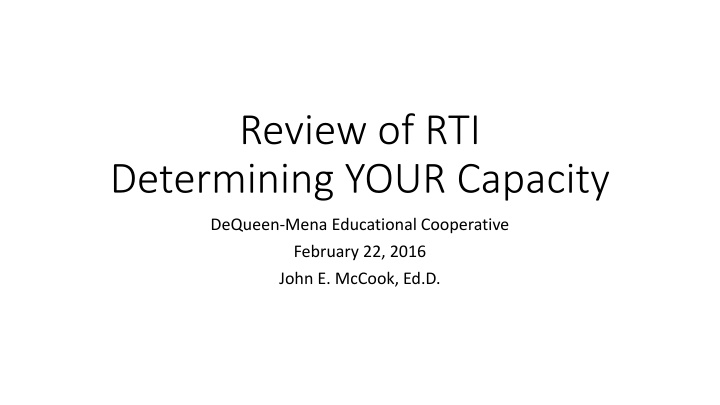
Implementing RTI for Student Success: Strategies and Critical Questions
Explore the essential components of Response to Intervention (RTI) implementation, including phases, non-negotiable factors, theoretical foundations, and critical questions for assessing student needs. Discover how district-level leadership teams can support effective RTI practices to improve student outcomes in reading, writing, and math.
Download Presentation

Please find below an Image/Link to download the presentation.
The content on the website is provided AS IS for your information and personal use only. It may not be sold, licensed, or shared on other websites without obtaining consent from the author. If you encounter any issues during the download, it is possible that the publisher has removed the file from their server.
You are allowed to download the files provided on this website for personal or commercial use, subject to the condition that they are used lawfully. All files are the property of their respective owners.
The content on the website is provided AS IS for your information and personal use only. It may not be sold, licensed, or shared on other websites without obtaining consent from the author.
E N D
Presentation Transcript
Review of RTI Determining YOUR Capacity DeQueen-Mena Educational Cooperative February 22, 2016 John E. McCook, Ed.D.
The Five Phases of Implementation Awareness Commitment Capacity Implementation Evaluation 3
Non Negotiable Components of RTI Non Negotiable Components of RTI 1. Universal screening 2. Multiple tiers of intervention 3. Progress monitoring 4. Problem-solving or standard protocol approach 5. Integrated data collection/assessment system 6. Scientific, research-based interventions 7. Fidelity 8. Professional development 4
Theoretical Foundation Theoretical Foundation Academic Systems Behavioral Systems Intensive, Individual Interventions Individual Students Assessment-based High Intensity Intensive, Individual Interventions Individual Students Assessment-based Intense, durable procedures 1-5% 1-5% Targeted Group Interventions Some students (at-risk) High efficiency Rapid response Targeted Group Interventions Some students (at-risk) High efficiency Rapid response 5-10% 5-10% Universal Interventions All students Preventive, proactive Universal Interventions All settings, all students Preventive, proactive 80-90% 80-90% 5
District level leadership team to meet regularly: Led by general education Elementary, middle and secondary Principal representation IT representation Exceptional children representation Federal programs representation Accountability/Data representation representation
The Critical Questions Do YOU have students who struggle in reading, writing or math? How do you know which students? How long does it take you to determine which students? What are YOU DOING about it? Where do you get help for these students? How does delivery of instruction change in YOUR classroom after you realize they struggle in reading, writing or math? How do you measure the child s understanding of your instruction? What do you do differently for the advanced student in your class?
The 80% Rule If 80% of your overall student population is not meeting state standards, then you have either a curriculum or instructional issue. Attempting to solve the problem by focusing only on individual students will never solve the problem it repeats itself annually. The above is true of disaggregated groups.
What interventions are we going to use? Common system wide Individual school determination Professional development
Progress Monitoring What are we going to use? How often? At what levels? How often do we communicate data to Decision making rubric parents?
Professional development Central office Building level Process versus interventions Continuing versus one time
Evaluation and data interpretation What happens to students? Data analysis
Tier 1 Non-negotiables Tier 1 STANDARDS-BASED CLASSROOM LEARNING: All students participate in general education learning that includes: Universal screenings to target groups in need of specific instructional support. Implementation of the Arkansas Performance Standards through a standards based classroom structure. Differentiation of instruction including fluid, flexible grouping, multiple means of learning, and demonstration of learning. Progress monitoring of learning through multiple formative assessments.
Tier 2 Non-negotiables NEEDS-BASED LEARNING: In addition to Tier 1, targeted students participate in learning that is different by including: Standard intervention protocol process for identifying and providing research based interventions based on need and resources. On-going progress monitoring to measure student response to intervention and guide decision-making.
Tier 3 Non-negotiables DRIVEN LEARNING: In addition to Tier 1 and Tier 2, targeted students participate in learning that is different by including: Intensive, formalized problem solving to identify individual student needs. Targeted research based interventions tailored to individual needs. Frequent progress monitoring and analysis of student response to intervention(s).
Universal Screening What are we going to use? At which levels? Individual school basis versus system norms Professional development
UNIVERSAL SCREENING: Elementary and Middle Reading ORF MAZE (Cloze System) Early Literacy Letter Sounds Nonsense Words Comprehension MAZE Retelling Math Calculation Concepts and application) Early Numeracy Letter Sounds Nonsense Words Comprehension MAZE Retelling
Universal Screening Universal Screening Curriculum-Based Measurement (CBM) is the recommended tool to identify students who are at-risk (have low academic skills) and require interventions. CBM is a technically sound and thoroughly researched progress monitoring system. 19
Universal Screening Universal Screening CBM: Is a standardized test Is given to everyone Measures critical skills Is brief Can be repeated frequently Is inexpensive and easy to administer and score Provides data to assist with decision making at the individual student, class, school or district level Tells us which students are at-risk and need supplemental instruction/intervention 20
Universal Screening Universal Screening Development of benchmark data norms Classroom Grade level School District Benchmark data taken three times per year Fall Winter Spring 21
Universal Screening Universal Screening Data from benchmarks must be available to teachers, principals, and district staff and shared with parents Data must be user friendly in format 22
Where are the Data? Where are the Data? Look at what you have User friendly? Quick? Ability to track over long haul? Ability to drill down to student and up to district or national? If yes, then you have tools. If no, then you need tools. 27
Typically CBM Data Probes When using CBM, the examiner gives the student brief, timed samples, or "probes," made up of academic material taken from the expected skills for the particular grade level. 28
Decision Making Tool Are between 5% and 20% of students struggling? Are over 20% of students struggling? Are 5% or fewer students struggling? Go to problem definition Go to problem definition Go to problem definition Examine instruction, curriculum and environment for needed adaptations and develop group Develop intervention Develop small group intervention Go to intervention evaluation individual student problem or a larger systemic problem?
Summative vs. Summative vs. Formative Assessment Formative Assessment Summative assessment occurs after instruction Example: High Stakes testing Conducted infrequently Does not provide teachers with ongoing assessment data Answers the question, Did the students learn? 30
Summative vs. Summative vs. Formative Assessment Formative Assessment Formative assessment occurs during instruction Example: CBM probes Conducted frequently Provides teachers with immediate feedback on student performance Answers the question, Are the students learning? 31
CBM CBM Formative Assessment Formative Assessment Dynamic measures are designed to be sensitive to short-term effects of instructional interventions Measures fluency, which is more sensitive to change than accuracy As a result, CBM probes are useful for progress monitoring. 32
Interpreting CBM Interpreting CBM What is an appropriate achievement level? At-risk range may be defined differently in different districts What is appropriate growth? Adequate improvement may be defined differently in different districts. 39
What is your progress in providing tiered services to students? Academic Behavioral Tier 1 Core for ALL Tier 2 Supplemental for SOME Tier 3 Intensive for FEW
Interventions are NOT Preferential seating Shortened assignments Parent contacts Classroom observations Suspension Doing MORE of the same / general classroom assignments Retention Peer-tutoring
Tier I Intervention Focus For all students Program Scientifically Based Curricula Grouping Multiple grouping formats to meet student needs Time 90 minutes per day or more Assessment Benchmark assessment at beginning, middle, and end of the academic year Interventionist General education teacher Setting General education classroom
Tier II: Supplemental Instruction Focus For students identified with marked difficulties, and who have not responded to Tier I efforts Program Programs, strategies, and procedures designed and employed to supplement, enhance, and support Tier I Grouping Homogeneous small group instruction (1:3, 1:4, or 1:5) Time Minimum of 30 minutes per day minimum 3 x per week in small group in addition to 90 minutes of core instruction Progress monitoring weekly on target skill to ensure adequate progress and learning (preferably 2x weekly) Personnel determined by the school (e.g., a classroom teacher, a specialized teacher, an external interventionist) Assessment Interventionist Setting Appropriate setting designated by the school; may be within or outside of the classroom
Tier III Focus For students identified with marked difficulties, and who have not responded to Tier I or Tier II efforts Sustained, intensive scientifically based interventions Program Grouping Homogeneous small group instruction (1:1, 1:2, or 1:3) Minimum of three 30 minutes per day in small group or individually in addition to core instruction Time Assessment Progress monitoring twice a week or at a minimum weekly on target skill to ensure adequate progress and learning Personnel determined by the school (e.g., a classroom teacher, a specialized teacher, an external interventionist) Appropriate setting designated by the school; may be within or outside of the classroom Interventionist Setting
Tier I is Critical!!! Tier I is Critical!!! Scientifically based curriculum delivered with FIDELITY Continues during Tier II Continues during Tier III The better Tier I is the fewer children will become Tier II or Tier III! 46
Tier II Implementation Tier II Implementation Tier I Classroom Teacher provides scientifically based research curriculum Teacher provides additional help to struggling students Teacher takes data through classroom activities and progress monitoring for at-risk students prior to going to Tier II after going to Tier II, PM done at Tier II Tier II Intervention Scientifically researched intervention provided in ADDITION to classroom Progress monitoring occurs at least weekly and preferably twice per week 47
Tier III Implementation Tier III Implementation Tier I Classroom Tier III Tier II is deleted At least two 30 minute interventions for a targeted student per day for at least 45 days within 60 school days Progress monitoring is twice per week Teacher provides scientifically based research curriculum Teacher provides additional help to struggling students Teacher takes data through classroom activities and progress monitoring for at-risk students prior to going to Tier II after going to Tier III, PM done at Tier III 48
Tier 1 Non-negotiables Tier 1 STANDARDS-BASED CLASSROOM LEARNING: All students participate in general education learning that includes: Universal screenings to target groups in need of specific instructional support. Differentiation of instruction including fluid, flexible grouping, multiple means of learning, and demonstration of learning. Progress monitoring of learning through multiple formative assessments.
Tier 2 Non-negotiables NEEDS-BASED LEARNING: In addition to Tier 1, targeted students participate in learning that is different by including: Standard intervention protocol process for identifying and providing research based interventions based on need and resources. On-going progress monitoring to measure student response to intervention and guide decision-making.
Tier 3 Non-negotiables In addition to Tier 1 and replacing Tier 2, targeted students participate in learning that is different by including: Intensive, formalized problem solving to identify individual student needs. Targeted research based interventions tailored to individual needs. Frequent progress monitoring and analysis of student response to intervention(s).
Decision Point Student at or below 10th Percentile: Begin the appropriate forms to take student to the S-Team Student above 10th Percentile: Continue working with student in the classroom OR Go to the S-Team for input and further assistance



